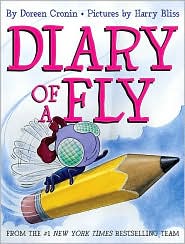

By: Dawn Wilson
Diary of a Worm/Diary of a Fly
By Doreen Cronin
About the Author
Doreen Cronin is the New York Times bestselling author who brings fiction and facts together in her books: Diary of a Spider, Diary of a Worm, and Diary of a Fly. She lives in New York with her husband and their daughters.
Author's Website:
http://www.doreencronin.com/doreen.html
Day 1
The students will gather around the easel in the writing center with their writing journals and a pencil in hand. On the easel, I will have a large graphic organizer, identical to the one that the children will be using throughout this activity. I will first show the students the books: Diary of a Fly and Diary of a Worm. I will identify the author and share information about her. I will explain that she lives in Brooklyn, NY. We will look at our classroom map to determine where she lives in comparison to the students in the classroom.
Next, I will explain that Ms. Cronin uses her books as a way to mix factual information with a fictional story. I tell them that our assignment for the day is to listen closely to the story, Diary of a Fly to find any facts Ms. Cronin has shared with her reader. I explain that Ms. Cronin had to research flies to find out facts about them. I will encourage them to write any facts that they hear in their writing journal. After I finish reading, I will introduce the large graphic organizer on the easel. This organizer is set up in columns and boxes. At the top of each column, I have pre-written a specific topic that relates to flies. For example, What do they eat? How do they travel? How big are their families? How many eyes do they have? Who are their enemies? What other interesting facts have you learned? I will ask the students to help me answer the questions by thinking about what the author told us. I will model how students can use an organizer to help them clarify their thoughts and write down important information by placing the facts in the correct column.
Day 2
Students will gather at the writing center and we will begin the lesson similarly to Day 1. Yesterday's graphic organizer will be displayed on the writing center wall to help guide students in today's activity. Today we will read aloud the book, Diary of a Worm. Students will again listen to the story and write down the factual information they learned from the author. After we finish the reading, I will have the new graphic organizer on my easel with questions/topics that relate to worms. Together, the students and I will fill in the important information from the story.
When we are finished filling in our chart, I will explain that they are going to do their own research, much like the Ms. Cronin did when she wrote her books. I explain that they are to choose an animal, insect, arthropod, or amphibian. I remind them that they learned about these living things in their science book. I explain that their science textbook might be a good place to start. After they choose their topic, they need to make a list of questions they want answered about their topic. Next, they are to research it and fill in the graphic organizer, writing down what they learned. When they are finished, I will ask them to complete a one-page report using the information they have accumulated on the graph. Each of these steps will be listed on a large poster board in the writing center.
Ohio Standards (Benchmarks)
Grade 3
Process: Apply knowledge of graphics and other organizers to clarify ideas for writing.
Conventions: Use correct grammatical structures, punctuation and capitalization in their writing.
Communication: Follow step-by-step directions
Research: Generate questions for investigation and gather information from a variety of sources.
No comments:
Post a Comment